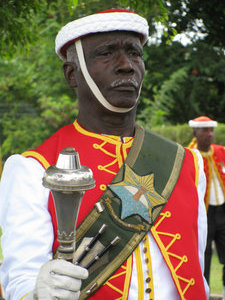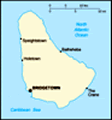Advertisement
Published: December 24th 2012

 Drum Major
Drum Major
The Zouave uniform of the West India RegimentNormally I put group tours in the same category as whiny children and bad hangovers: things to be avoided at all cost. Fortunately, the Garrison Heritage Tour was a happy exception.
I’m interested in military history, and for a long time I had wanted to see some parts of Garrison that are not normally open to the public, like the armoury and the inside of the Main Guard building. So, when I saw the small ad in the local newspaper pitching “Historic Garrison” tours to residents, my interest was definitely piqued.
We started the our visit at the George Washington House, a place I have visited before. (See my blog
George Washington Slept Here) However, since my previous visit, several miles of tunnels underneath the area have been discovered, some leading to St. Ann’s Fort, some leading to former soldier’s barracks. Today you can only see the tunnels through a live video feed that is shown in the Washington House theatre, but the tunnels – at least some of them – are expected to be open to the public sometime in 2013.
Across the Parade Grounds is St. Ann’s Fort. This is an active military complex and home to the Barbados
Defense Force. As such, it is not open to walk-ins. In the Officer’s Mess are some rather dusty relics, including the last British flag to fly over Barbados before its independence in 1966, and drawings of the uniforms of the West India Regiment through the ages.
Little Known Fact: The British Army bought slaves for the West India Regiment during the 1790s to fight the French in the Caribbean. Immediately upon enlistment slaves became free men, and were paid wages as a British soldier, though at a lower rate them their white counterparts.
The real draw here, though, is the National Armoury. Located under St. Ann’s fort, the armoury is now home to a marvelous museum of old cannon, including one of only two intact Cromwell cannon left in the world, and the only Elizabethan cannon of its kind anywhere. You will also find the origin of the phrase “cold enough to freeze the balls off a brass monkey” here, and no, it’s probably not what you think.
The National Armoury is also home to a recreation of the Mermaid Tavern where the Charter of Barbados was signed in 1652. This charter gave Barbados rights unheard of
throughout the colonial empire, including the right of no taxation without representation. George Washington likely became familiar with the Charter of Barbados during his stay here, and several of the articles in the Charter are strikingly familiar to articles in the Constitution of the United States.
Next stop was the Changing of the Sentry in front of the Main Guard. What can I say? This building, not normally open to the public, is a marvelous example of British colonial architecture. The Changing of the Sentry, while colorful, is a show for tourists. Nice drumming, though.
The tour ended at Charles Fort, on the grounds of the Barbados Hilton. Not much is left of the fort as the Hilton was built on top of it, but the original gun mounts facing out into Carlisle Bay are still in existence. Adjacent to the Hilton, but not part of the tour, is the Barbados Military Cemetery. The cemetery itself dates back to about 1780, and is still in use for members of the Barbados Defense Force.
The
UNESCO World Heritage Site of Historic Bridgetown and Its Garrison is much bigger than this three hour tour encompasses, but this is a
good start, and narrows its focus to military history. I like Barbados a lot, and, unlike many Caribbean islands, many of its historical sites are still extant, though not always in good repair.
The Garrison Consortium, the people who put together this tour, are doing their best to preserve the history of the island and make it accessible to all. James Blades, President of the Consortium, and Kim, the other guide, are two of the most knowledgeable guides I’ve ever met. (I once had a guide tell me that a marathon was 22 miles!) When asked a question about cannon that he couldn’t answer, James got on the phone to Major Michael Hartland, the premier expert on Barbados military history, and the author of several books on the subject.
They have other tours in the planning stages, and I wish them the best.
Oh, and the origin of “cold enough to freeze the balls off a brass monkey”: This comes from the necessity of keeping loose cannon balls from rolling around on the deck of a ship. A square metal plate, called a monkey, with indentations in it was used to keep the first layer of cannon
balls in place. Subsequent layers were stacked on top in the form of a four sided pyramid. The first monkeys were made from iron, as were the cannon balls. Exposure to the elements would cause the cannon balls to rust to the monkey, rendering them unusable.
Enter the brass monkey. While the iron balls did not fuse to the brass, in cold weather the iron balls would contract at a faster rate than the brass allowing the balls to roll free. Now some people dispute this etymology, but this is the story told here, and I’m sticking to it.
Advertisement
Tot: 0.899s; Tpl: 0.037s; cc: 37; qc: 125; dbt: 0.2161s; 1; m:domysql w:travelblog (10.17.0.13); sld: 1;
; mem: 1.4mb






















D MJ Binkley
Dave and Merry Jo Binkley
I love the quote you started your blog with!
I must have spent to much time on the beaches of Barbados and too little time researching a bit of history. Washington slept there? Really? Huh.